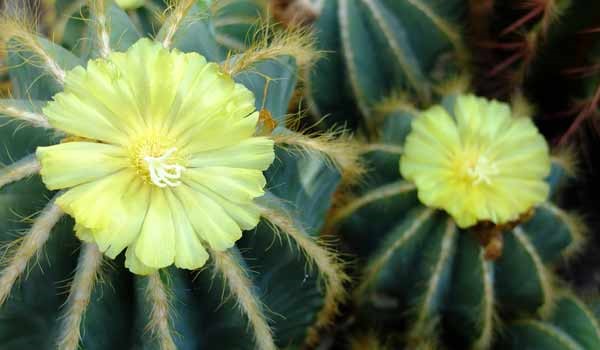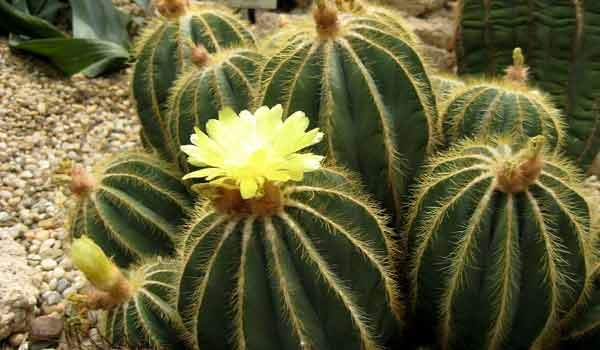Parodia Magnifica (Ball Cactus) Grow & Care Guide

Most of the exotic and beautiful cacti that we know originate in Mexico, but Parodia Magnifica comes from southern Brazil. Parodia Magnifica common names include Ball Cactus, Green or Blue Ball Cactus, and Balloon Cactus.
According to the IUCN Red List, this flowering round cactus is considered endangered species. So by getting and growing a Parodia Magnifica, not only you are complimenting your home décor, but also you are contributing to the Ball Cactus’s act of conservation. Here is all you need to know about this plant and its care.
An Overview on Ball Cactus
As we mentioned, Green Ball Cactus is native to Brazil; but you can find it in some regions of Paraguay and Argentina as well. Coming from the Cactaceae family, Parodia Magnifica is actually one of several species.
The Balloon Cactus size is only one of the things that make growing it indoors easy. In its habitat, it reaches up to 3 – 6 inches (7 to 15 cm) in height and up to 18 inches (45 cm) in width. When growing it in a pot, you will be able to decide how much your green friend can grow. Parodia Magnifica can offset and form a cluster as well.
As you can tell by its name, the Balloon Cactus has a globular shape. However, as it ages, its shape changes into a cylinder rather than a ball. It is also covered with 11 to 15 straight ridges. The ridges are finely symmetrical and are lined with brown spikes that turn yellow when older.
On the top of this plant, you can see a small indent. That is where the Balloon Cactus blooms in the summer. Its flowers are yellow and small (2.2 inches long and wide) and look like little crowns for the cactus.
Among all the things that change about change Ball Cactus as it grows older, we can include its body color as well. It is green at first but takes on a bluer tone as it grows (hence one of its names).
Parodia Magnifica F. Aurata
When looking for information about this plant, you may have heard of Parodia Magnifica f. Aurata. This is actually the Ball Cactus’s mutant sibling with almost no chlorophyll pigments. This gives the f. aurata a unique yellow-golden color and makes it a great candidate for growing with the Balloon Cactus to create a more eye-catching view.
Tip: In case you decided to dig deeper about this plant, it is good to know that besides the botanical and Parodia Magnifica common names, the Ball Cactus has two more synonyms as well: Notocactus Magnificus and Eriocactus Magnificus.

Parodia Magnifica Care and Grow
This cure cactus is another succulent that requires minimum care and zero pruning. Below, you’ll see what this plant needs to maintain a healthy growth rate:
Light
In addition to warm temperatures, Parodia magnifica loves sunlight too. Specifically, if you are growing it outdoors. In this case, it is best to place it in a half-shaded spot, so it can get full sunlight in the mornings when the light is not harsh.
During winter, bring your dormant cacti inside (especially if you are not living in a continuously warm climate) to make sure that it gets enough sunlight. Do not forget to rotate its pot from time to time for an elegant growth pattern and avoid skewing.
Temperature
The Ball Cacti thrives best in warmer climates. It can survive cold temperatures as low as 20 degrees Fahrenheit, but only for short periods and it will not be very healthy during this time. When cultivating, temperatures above 50 degrees Fahrenheit are suitable for this cacti.
Water
The Parodia Magnifica needs the most watering during its growing season, but you should not make its soil soggy. When the soil is dry to the touch, you can water your Ball Cacti. During the winter months and when it is dormant, place it in a cool room and do not water it at all.
Soil
Airy soils are your best option for Ball Cactus care. You can simply combine store-bought cacti blends with some perlite or combine coarse sand, perlite/pumice, and regular soil mix to make the suitable soil from the scratch.
Feeding
This succulent appreciates fertilizer during its growing months. So, if you have the right fertilizer, or you feel that your cactus is not as vibrant as before, add some diluted nitrogen fertilizer. Avoid feeding your plant in the winter.
Potting
Whether you want to plant or repot your Green Ball Cactus, do it during its growing season to maximize your chance of success. Also, do not forget to use gloves. If your cactus is not young, its spikes can hurt badly.
When choosing a new pot, remember that the Rounded Ball cactus tend to grow in a cluster as it becomes mature. So it needs some extra space to develop new bulbs. If you prefer to keep your Parodia Magnifica as a single plant, any pot will be a good choice. But go for a small pot to avoid overwatering.
Diseases and Pests
Parodia Magnifica is a hardy plant when it comes to diseases and pests. However, depending on its surrounding plants and environment, it is known to develop aphides while flowering. So we recommend paying extra attention to its growth and when deciding its spot. Also, beware of mealybugs.
You may also discoloration or marks on your plant, which indicates over-watering. To make the situation better, let the Blue Ball Cactus dry, or repot it in a dry soil mix. To avoid overwatering, as mentioned above, water every time the soil is completely dry.

Rounded Ball Cacti Propagation
Similar to Parodia Magnifica care, propagating this plant is also convenient; unless you want to grow it from seeds. You can sow the seeds in the growing season or purchase them from a reputable dealer, but they require effort and time to grow successfully.
They need moisture, warmth (66 to 75 °F), the right soil, a plastic wrap to cover them, and a shaded environment like many other seeds. But this method will take considerably longer with a variable success chance.
For this reason, we recommend using offsets instead of Parodia Magnifica seed. To propagate using offsets, you need to:
- Cut the offsets from the mother plant using a sharp and clean razor or knife.
- Leave the cuttings for a couple of day to callous. It can take one or more than one days depending on where you place them to dry.
- When the cut has calloused, push this part in the soil so the roots start to grow.
- Do not water for a week so the Ball Cactus feels comfortable in its new home.
Tip: Regardless of the method that you choose, start the propagation process during spring, summer, or latest early fall. Winter is the worst time for propagating unless you are highly experienced.
This combination of the easy Parodia Magnifica care, its symmetrical and highly decorative shape, with charming flowers, makes the Rounded Ball Cacti a must-have plant. Whether grow it as a single plant or let it cluster, it can brighten up any place instantly.
- In this post:
- An Overview on Ball Cactus
- Parodia Magnifica Care and Grow
- Rounded Ball Cacti Propagation



